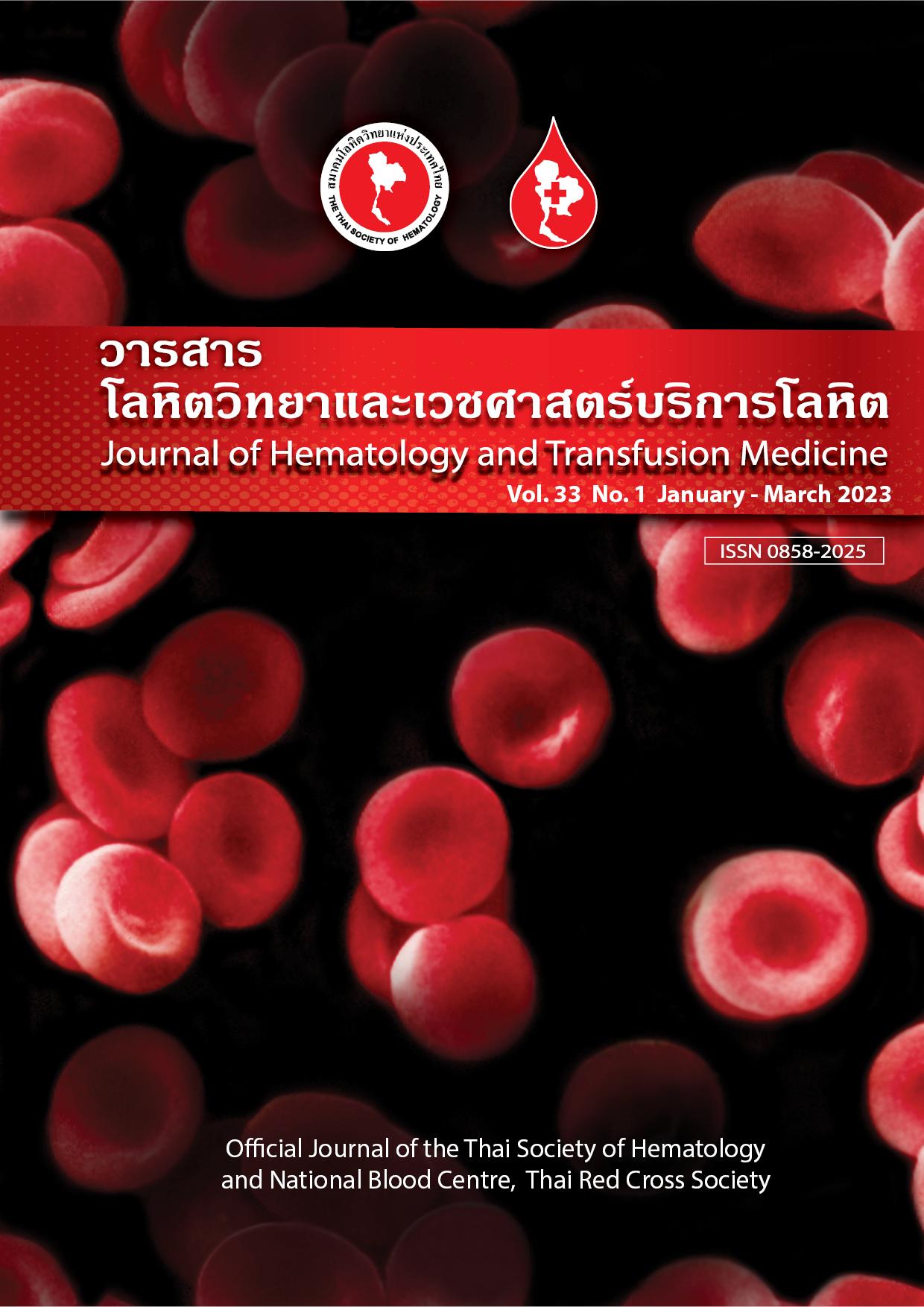A study of the effectiveness for glycerolization and deglycerolization blood of ACP215 Automated Cell Processor, Haemonetics
คำสำคัญ:
กระบวนการแช่แข็ง, ผลิตภัณฑ์เม็ดเลือดแดงแช่แข็ง, กระบวนการล้างเซลล์เม็ดเลือดแดงแช่แข็ง, ดีกลีเซอไรด์เรดเซลล์บทคัดย่อ
บทคัดย่อ
บทนำ ผลิตภัณฑ์เม็ดเลือดแดงเป็นผลิตภัณฑ์ที่ใช้รักษาโรคทางการแพทย์ในผู้ป่วยที่สูญเสียเลือดหรือมีเลือดในร่างกายไม่เพียงพอต่อความต้องการของร่างกาย เช่น ผู้ป่วยธาลัสซีเมีย โรคโลหิตจางจากไขกระดูกฝ่อ มะเร็งเม็ดเลือดขาวชนิดเฉียบพลัน และผู้ป่วยที่มีเลือดหายากในคนไทย (rare blood type) ผลิตภัณฑ์เม็ดเลือดแดงแช่แข็งจึงเป็นอีกทางเลือกหนึ่งของธนาคารเลือด ที่ช่วยยืดอายุในการเก็บรักษาเลือดหายาก เพื่อให้นำเลือดหายากมาใช้ในการรักษาผู้ป่วยได้ทันท่วงที วัตถุประสงค์ เพื่อศึกษาประสิทธิภาพของการแช่แข็งเม็ดเลือดแดงและการล้างเม็ดเลือดแดงแช่แข็งด้วยเครื่อง ACP215 Automated Cell Processor, Haemonetics ในผลิตภัณฑ์เม็ดเลือดแดงของผู้บริจาคโลหิตของศูนย์บริการโลหิตแห่งชาติ สภากาชาดไทย วัสดุและวิธีการ คัดเลือกเลือดของผู้บริจาคจำนวน 14 ยูนิต บันทึกค่าฮีมาโตคริต (hematocrit; Hct) และน้ำหนักของเลือดในเครื่องอัตโนมัติ เพื่อให้เครื่องเติม glycerol ในปริมาตรที่เหมาะสมเข้าไปในถุงสำหรับแช่แข็ง หลังจากนั้นปั่นแยกเอา supernatant glycerol ออกแล้วนำเลือดไปแช่แข็งที่อุณหภูมิ -80 องศาเซลเซียส เป็นเวลานานมากกว่า 1 สัปดาห์ จากนั้นนำเลือดออกมาทำ deglycerolization ประกอบด้วยการนำเลือดมาละลาย ติดตั้ง set เข้าเครื่อง จากนั้นบันทึกค่า Hct และน้ำหนักเลือดหลังการอุ่นเลือดในเครื่องอัตโนมัติและใช้น้ำยา SAG-M เป็นน้ำยารักษาสภาพเซลล์ซึ่งจะทำให้เม็ดเลือดแดงมีอายุหลังการล้าง 72 ชั่วโมง การตรวจคุณภาพหลังการล้างประกอบด้วย ค่า Hct ค่า hemolysis ค่า osmolarity และ ผล bacterial culture ในวันที่ 0 ถึงวันที่ 5 หลังจากการล้างเซลล์ ผลการศึกษา พบว่า ก่อนการแช่แข็งค่าเฉลี่ย Hct ตั้งต้นเท่ากับ 74.2% และผลการทดสอบหลังการล้างในวันที่ 0 และ 5 มีค่า Hct อยู่ที่ 37.9-55.1% ค่า hemolysis 0.11-0.98% ค่า osmolarity 342-386 mOsm/kg และปราศจากเชื้อในวันที่ 0 - 4 พบว่ามีการสูญเสียความเข้มข้นของเลือดไปประมาณ 39.4% สรุป จากการศึกษาการแช่แข็งเม็ดเลือดแดงด้วยเครื่อง ACP215 Automated Cell Processor และเก็บที่อุณหภูมิ -80 องศาเซลเซียส พบว่า ช่วยยืดระยะเวลาในการเก็บรักษาเลือดได้ยาวนานและล้างเม็ดเลือดแดงแช่แข็งด้วยเครื่องอัตโนมัติแบบระบบปิด ผลการควบคุมคุณภาพผ่านเกณฑ์ตามมาตรฐาน The European Directorate for the Quality of Medicines & HealthCare (EDQM, Council of Europe) และ Association for the Advancement of Blood & Biotherapies (AABB) โดยภายหลังการล้างเซลล์มีเวลาในการใช้เลือดได้นาน 72 ชั่วโมง ซึ่งช่วยขยายเวลาในการขนส่งเลือดไปยังโรงพยาบาลต่างจังหวัด ส่งผลให้ให้ผู้ป่วยที่มีเลือดหายากเข้าถึงกระบวนการรักษาได้ทันเวลา
Abstract:
Introduction: Red blood cell products are for medical use for patients who lose blood or have insufficient blood for the needs of the body. For instance, patients with thalassemia, aplastic anemia, acute leukemia, etc. and Thai patients with rare blood types. Therefore, frozen red blood cell are an alternative blood products that extends the shelf-life of rare blood to be immediately utilized to treat patients on time. Objective: To study the efficiency of glycerolization and deglycerolization of frozen red blood cells with the ACP215 Automated Cell Processor, Haemonetics in red blood cell products of blood donors of National Blood Centre, Thai Red Cross Society. Materials and Methods: Altogether, 14 units of blood from donors were studied by enter the Hct, and blood weight in the machine, then the machine will add the appropriate volume of glycerol into the freezing bag. After centrifugation, the glycerol supernatant is removed, then freeze the blood product at -80 degrees Celsius for more than 1 week. Then take the bag out for deglycerolization and connect to set deglycerolization by install set to the machine and enter Hct and blood weight after warming up in the machine. The SAG-M solution was used as cell preservative solution that kept the red blood cells for 72 hours. The quality controlling after washing included determining the hematocrit, hemolysis, osmolarity, and bacterial culture results on days 0-5. Results: It was found that the average of Hct before freezing was 74.2%. but, the quality test results after washing on day 0-5 had Hct values of 37.9-55.1% , hemolysis was 0.11-0.98%, osmolarity was 342.0-386.0 mOsm/kg, and sterility test on day 0 – 4 were negative. Totally found that the loss of blood concentration is about 39.4%. Conclusion: From this study, it has been shown that red blood cell freezing with the ACP215 Automated Cell Processor can freeze blood at -80 degrees Celsius to help extend the storage time of the blood. The frozen red blood cells can also be washed with the Automated in a closed system and the quality control results meet the standard guidelines. After deglycerolization the blood can be used for 72 hours, which provide additional time of blood transportation to the hospital so that the patients with rare blood can access the treatment process promptly.
Downloads
เอกสารอ้างอิง
Anastasiadi AT, Tzounakas VL, Kriebardis AG, Stamoulis KE, Seghatchian J, Antonelou MH. When I need you most: frozen red blood cell for transfusion. Transfus Apher Sci. 2020;59:102786. doi: 10.1016/j.transci.2020.102786.
National Blood Centre, Thai Red Cross Society. Standards for blood bank and transfusion services. 4th ed. Bangkok: National Blood Centre; 2015. p. 14-6.
Smith AU. Prevention of hemolysis during freezing and thawing of red blood cells. Lancet. 1950;2:910. doi: 10.1016/s0140-6736(50)91861-7.
Krijnen HW, de Wit JJ, Kuivenhoven AC, Loos JA, Prins HK. Glycerol treated human red cells frozen with liquid nitrogen. Vox Sang. 1964;9:559-72.
Eades B. Freezing and recovering rare red blood cells using glycerol. Immunohematology. 2020;36:85-8.
Henkelman S, Noorman F, Badloe JF, Lagerberg JW. Utilization and quality of cryopreserved red blood cells in transfusion medicine. Vox Sang. 2015;108:103-12.
Chaudhari CN. Frozen red blood cell in transfusion. Med J Armed Forces India. 2009;65:55-8
Cohn CS, Delaney M, Johnson ST, Katz LM. Technical manual. 20th ed. Bethesda, MA: American Association of Blood Banks; 2020.
American Association of Blood Banks. Technical manual. 20th ed. Bethesda, MD: American Association of Blood Banks; 2020.
Council of Europe. Guide to the preparation, use and quality assurance of blood components. 20th ed. Strasbjourg: Council of Europe; 2020. p. 217-9.
Turner T, Hansen A, Kurach J, Acker JP. From development to implementation: adjusting the hematocrit of deglycerolized red cell concentrates to meet regulatory standards. Transfus Med Hemother. 2017;44:30-8.
Verleri CR, Ragno G, Pivacek LE, Cassidy GP, Srey R, Hansson-Wicher M, et al. An experiment with glycerol frozen red blood cells stored at -80C for up to 37 years. Vox Sang. 2000;79:168-74.
Myhre BA. Marcus CS. The extension of 4C storage time of frozen – thawed red cells. Transfusion. 1992;32:344-8.
Sen A, Khetarpal A. Comparative study of automated cryopreservation of red blood cells. Med J Armed Forces India. 2013;69:345-50.
Valeri CR, Ragno G. Cryopreservation of human blood products. Transfus Apher Sci. 2006;34:271-87.
Meryman HT, Hornblower M. A method for freezing and washing red blood cells using a high glycerol concentration. Transfusion. 1972;12:145-55.
ดาวน์โหลด
เผยแพร่แล้ว
ฉบับ
ประเภทบทความ
สัญญาอนุญาต
ลิขสิทธิ์ (c) 2023 วารสารโลหิตวิทยาและเวชศาสตร์บริการโลหิต

อนุญาตภายใต้เงื่อนไข Creative Commons Attribution-NonCommercial-NoDerivatives 4.0 International License.



